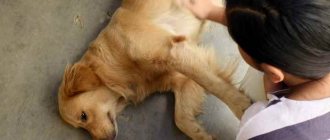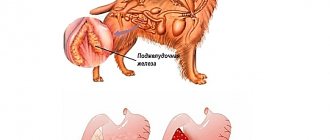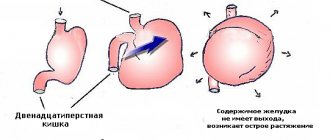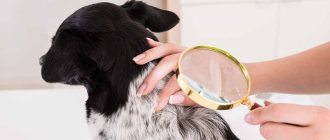Cataracts in dogs are one of the most common eye diseases. The most characteristic symptom of this disease is clouding of the lens. Why is this happening? We will tell you in our article how to recognize the disease and how to cure cataracts in a dog.
With cataracts, protein denaturation (folding) occurs. As a result, insoluble milky-white fibers appear inside the lens. Why do the proteins inside the “natural lens” fold, and what can cause cataracts in a dog?
Causes
Scientists are still trying to discover what exactly leads to clouding of the lens. They unanimously settled on one cause of cataracts in dogs – genetic predisposition. It has already been proven that in 8 out of 10 cases a puppy will have cataracts in the future if at least one of the parents had this disease. However, there are other reasons that lead to cataracts, so to speak, contributing ones. These include:
- Injury. Impact, scratch, constant mechanical irritation.
- Eye burns. Chemical, thermal (albeit less frequently), ultraviolet.
- Diabetes mellitus is the most common cause of cataracts in dogs.
- Problems with the immune system (weak immune response). Also, if the dog develops the same infectious disease more than once a year.
- Poisoning. Medicines and chemicals, but more often alcohol. You can't give your dog alcohol!
- Senile change. Well, who is not affected by age? Both people and animals suffer from a variety of diseases as they age. And one of them is cataract.
Breed Predisposition
Poodles (in particular, toy, dwarf and royal) suffer from this disease most often. Spaniels (American and English), miniature schnauzers, terriers, golden retriever. However, representatives of other breeds can also suffer from lens clouding.
How is the diagnosis carried out?
It will not be possible to make an accurate diagnosis on your own. Therefore, you need to go to a clinic, where a veterinarian will examine your pet and refer you to an ophthalmologist for an eye examination and an accurate diagnosis.
The following will be held there:
- polymerase chain reaction (PCR) analysis;
- retinal function assessment test using side lighting;
- Ultrasound and electroretinograms.
Additionally prescribed:
- a blood test to evaluate the underlying cause of the dog's cataracts;
- a comprehensive blood test to rule out inflammation, infection, anemia and other similar conditions;
- examination of the kidneys, liver, pancreas, and sugar levels.
Kinds
There are two types of cataracts in dogs:
- Primary. With this type, the disease is either congenital (a puppy is immediately born with this pathology) or acquired (it can develop after some disease). But how can a puppy be born immediately with cloudy eyes? Yes, it’s very simple, he could “get sick” of an infectious disease in the womb (together with his mother), suffer from toxins (if the mother dog was poisoned) or even injury (if a pregnant mustache was beaten, he fell, etc.). The primary cataract in a dog will also be one that develops as a result of aging. And it occurs in 4 stages. Secondary. Here, cataracts occur together with another disease. That is, the dog’s lens becomes cloudy, but at the same time the pet has some other disease. Secondary cataract is a symptom of another pathology developing in the body.
Stages of disease development
Having recognized from the symptoms that your pet has problems with his eyes, you can begin treatment, thereby preserving your pet’s vision for a longer period. In total, there are 4 stages of cataract development in dogs:
| Initial | The very beginning. And it lasts for more than one year. Initial changes are invisible to the naked eye. To confirm that a dog has developed cataracts, it is necessary to undergo an examination at a veterinary clinic with good equipment. |
| Immature | The cataract is beginning to gain momentum, but the veterinarian will not perform surgery at this stage. It will be necessary to wait until the disease progresses to the next stage. Vision begins to gradually decline. |
| Mature | At this stage, the symptoms of cataracts are already noticeable. Vision almost completely disappears. It is at this stage that surgery must be performed. |
| Overripe | It is better not to reach this stage of the disease, otherwise the treatment of the dog will be complicated. Yes, they are operating on it. But the longer the animal owner delays, the less likely it is that the mustachioer’s vision can be restored. |
How quickly cataracts develop in a dog depends on the individual characteristics and health status of the animal, as well as on external factors.
Unfortunately, owners often notice too late that their pets have problems with eye health, and turn to the veterinary clinic already at the stage of a mature or overripe form of cataract, which makes drug treatment impossible. Therefore, the dog is sent for surgery.
Features of lens opacification in the initial stages
Initial cataracts are characterized by minor changes in the lens. Imaginary objects in the field of lateral vision, glare, and “floaters” may be observed. The clarity of visible objects decreases, and sensitivity to light becomes painfully worse. If changes in the lens begin in the cortical zone, for a long time the cataract may remain unnoticed or not significantly affect the quality of life. With this development of pathology, vision decreases slowly and almost imperceptibly over several years. However, new zones from the periphery to the center of the lens are gradually involved in the pathological process.
Cases of nuclear development of cataracts are also common. The focus of changes in the lens in this variant is localized in the central part. Vision deteriorates significantly in the first months.
Immature cataracts are diagnosed when the entire lens is affected by clouding to one degree or another. There is a clear decrease in visual acuity. Objects appear blurry, appear double, and sometimes have a halo or glow along the contour. It's like seeing through water or cloudy glass.
Since cataract maturation is characterized by an increase in the size of the lens, secondary (phacogenic) glaucoma may develop due to impaired fluid circulation in the eye chamber.
Symptoms
The most striking and reliable symptom of cataracts in a dog is clouding of the lens itself. When you look into the eyes of an animal, you can see how the circle in the middle (where the pupil was) is white, like a thorn. Such a whitish spot can appear on one or both eyes at the same time.
- At the beginning of the disease, such clouding may be insignificant. The dot will gradually increase in diameter. Over time, this “cloudiness” will occupy the entire space of the pupil. Essentially, the pupil is a “hole” that has the ability to increase and decrease in diameter. And the rays of light entering the eye through it cannot pass through the crystalline lens, which acts as a lens. Normally, the lens is transparent, so light passes through unhindered. And we see a black pupil.
- With cataracts, the light is “reflected” from the cloudy lens, thereby we see a white circle. This is how, even without special equipment, you can understand that your dog has problems with his eyes.
- Vision is impaired. And as a consequence of this cataract symptom, your dog starts bumping into things. He walks very carefully, taking his time. Refuses to play favorite games.
But don't discount the possibility that your dog may have another eye disease that may have symptoms similar to cataracts. Therefore, if you are not a qualified specialist in the field of canine diseases, it is better to consult a veterinarian regarding the tumor.
Using modern diagnostic methods and the latest medical equipment, specialists from veterinary clinics reliably identify the symptoms accompanying cataracts. The animal is examined both traditionally and using a new method, which makes it possible to make a more accurate diagnosis.
Below are examples of cataracts in dogs of different breeds:
Cataract. Symptoms and their recognition
Symptoms of cataracts do not always manifest themselves, and owners often notice them too late.
The main sign of the onset of the disease is the dog’s cloudy eyes.
Of course, if the animal’s age is approaching venerability, there is nothing wrong with the fact that the eyes have acquired a gray-blue tint and become less transparent.
This indicates the onset of nuclear sclerosis, which does not affect vision.
However, it is worth checking your dog if the decrease in vision becomes noticeable and the eyes become increasingly cloudy.
It is better to start treating cataracts in dogs right away, otherwise there is a high risk that they will slip out of the supporting tissues and the outflow of fluid in the eye will be blocked.
This may result in permanent blindness or glaucoma.
Symptoms of cataracts do not always manifest themselves, and owners often notice them too late. The main sign of the onset of the disease is the dog’s cloudy eyes.
Dogs' eyes, like human eyes, are susceptible to other diseases whose symptoms can be mistaken for cataracts.
If you have such suspicions, it is better to contact a specialist for qualified advice.
The capabilities of modern diagnostics and the good equipment of veterinary clinics make it possible to identify and identify symptoms characteristic of cataracts.
The examination is carried out traditionally and using a special technique, which increases the chances of a reliable diagnosis.
Unnoticed cataracts in dogs can lead to vision loss.
Treatment
How to treat cataracts in dogs? Treatment of the animal in this case, unfortunately, is exclusively conservative - surgically.
Drug treatment for cataracts in dogs does not provide 100% hope of recovery; it only allows to slow down the process of clouding of the lens. Medicines are prescribed at the very beginning of the disease (when surgery is not yet required). Most often, vitamin and enzyme preparations are required. There are drops: there are a huge number of them. However, again, they cannot completely cure the animal. Scientists are still trying to invent a medicine that will stop the disease (stop the clouding process).
The sooner the owner recognizes the first signs of a serious pathology and takes the pet for treatment, the greater the chance of timely surgical intervention. As you know, cataract removal in dogs is one of the most technically difficult operations performed on the mucous membranes, and the best effect can be expected from it at the initial stage of the disease.
Preoperative preparation
If partial or complete removal of the lens of the eye is planned, it is necessary for specialists to conduct a complete physical examination of your pet approximately 4 weeks before the planned operation. Since it will be performed under general anesthesia, the veterinarian must check whether the animal can physically endure the operation. To do this, your pet’s blood and urine will be analyzed, possible changes in blood pressure will be monitored, and its medical history will be assessed.
If an animal has diabetes, it is extremely important to conduct a preoperative blood test for all parameters.
In addition, veterinarians may recommend giving your dog eye drops for 14 days before surgery to relieve inflammation. Typically, Flurbiprofen is used for these purposes - proven anti-inflammatory drops for cataracts for dogs.
Cataract surgery for dogs
If we talk about the surgical method of treatment, it is worth mentioning that there are 2 methods.
- One is the oldest. It involves removing the old clouded lens and replacing it with an artificial one.
- The second method gives positive results even at the initial stage. It's called phacoemulsification.
The name is long and somewhat scary, but in reality the method is not that complicated. And this is a more modern way of treatment. Its essence is this:
A small puncture is made in the cornea, and the lens is crushed using ultrasound. Through the same puncture (no more than 2 mm) the crushed contents are removed. And in its place, a rolled up special artificial lens is inserted (IOL, intraocular lens, intraocular, to put it in plain English). As soon as the IOL gets into the cavity of the lens bag (after all, nothing should remain from the lens itself), it straightens out. And the animal can see again.
During the operation, it is recommended to use viscoelastics - gel medicinal solutions injected into the eye and protecting it from damage and infection during surgery. The use of additional means of protecting the eye membranes, as well as the treatment of surgical instruments with a “viscous” substance, increases the safety of the phacoemulsification procedure and mitigates the pain of its implementation.
Without sufficient reason, sutures are usually not placed on the eye. The puncture, gradually “self-sealing”, heals in about 10 days.
The highest quality artificial lenses, as determined by experts, are produced by German companies.
The cost of the operation varies depending on the severity of the disease, the city, the qualifications of the doctor and the equipment of the veterinary clinic. However, you should not count on a price below 12,000 rubles for one eye. If both eyes of the dog are cloudy, the doctor will begin the operation with the one with less damage. After 3 months, the second one will be operated on. The fact is that in the initial and immature stage the lens is still elastic, and phacoemulsification takes place with a minimum of complications.
Treatment without surgery: fact or fiction
Unfortunately, treating cataracts in dogs without surgery is not possible. And, as already mentioned, the only way to get rid of cataracts is a surgical operation, during which, successfully or not (depending on various factors), the clouded lens is replaced with an artificial analogue.
Prevention
There is no specific prevention for cataracts in dogs. The fact is that no diet, super-high-quality food or constant intake of vitamins will save your pet from this disease. However, they significantly reduce the risk of developing diseases of the eyes and other organs and organ systems of the animal.
All you can do is examine your pet’s eyes and visit the veterinarian at least once a year (especially if the mustache has a breed or hereditary predisposition). It is very important to study the pedigree of your four-legged friend. If he had “relatives” in his family with cataracts, then there is a high risk that your dog will also have problems with his eyes. Alas, clouding of a dog’s lens is inherited.
Cataracts in dogs: main symptoms
As many photos show, the main and most “bright” symptom of the development of the disease is considered to be clouding of the lens. In this case, if you look into the dog’s eyes, you can see how the circle where the pupil used to be has become white and cloudy. Such a spot can appear on both eyes at once, which is more dangerous for the dog.
At the initial stage of development of the disease, such a spot may not be very visible, but over time it will only increase in size. As a result of this, the rays will not be able to pass through such a spot, because the lens will no longer be transparent and will also not be able to act as a lens. Over time, the lens will become cloudy, so it can be compared to an ordinary white circle - at this moment it becomes visible to the naked eye that the animal is developing an ophthalmic disease.
Since the dog will not be able to see anything, it will walk more slowly, stop playing games, and will constantly bump into furniture and household objects. By looking at a photo of a cataract, you will be able to notice what the spot actually looks like, and you will also be able to distinguish it from other ophthalmological diseases.











